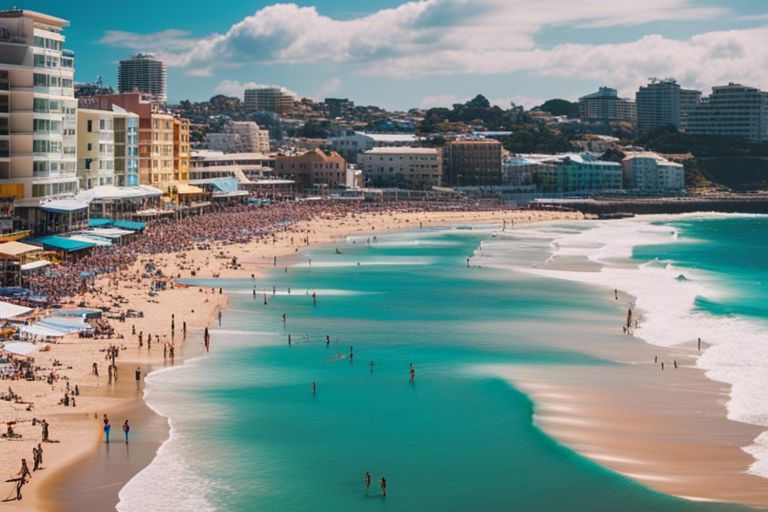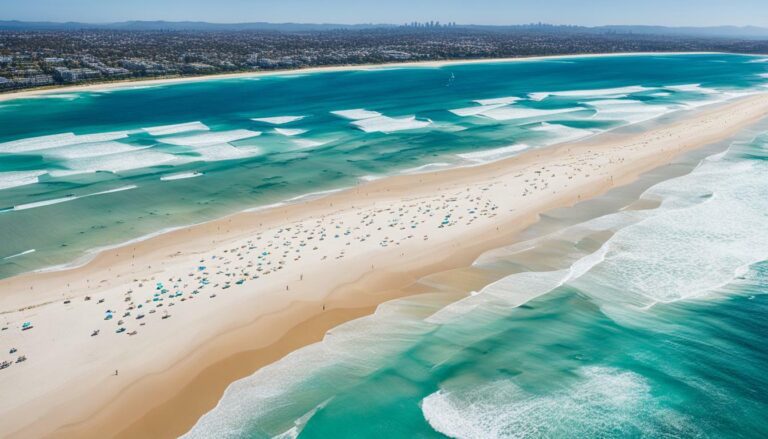The History And Evolution Of Bondi Beach
With its golden sands and iconic surf culture, Bondi Beach holds a rich history that has evolved over the years into the bustling hotspot it is today. From its humble beginnings as a quiet seaside retreat to becoming a world-renowned destination for beachgoers and surf enthusiasts, Bondi Beach has undergone significant transformations. Join me as we examine into the past and uncover the fascinating journey that has shaped the beloved Bondi Beach we know and love.

Key Takeaways:
- Colonial Origins: Bondi Beach, initially known as ‘Boondi Bay’, had a colonial past dating back to the 1800s when it was used for farming and as a source of fresh water.
- Transformation into a Popular Destination: Bondi Beach underwent a significant transformation in the early 20th century, evolving from a quiet coastal area to a vibrant and bustling hub attracting tourists and locals alike.
- Cultural Significance: Bondi Beach has become an iconic symbol of Australian beach culture and lifestyle, drawing surfers, swimmers, and sunbathers from around the world and showcasing a unique blend of history and modernity.
Indigenous Roots
The Original Inhabitants
While today Bondi Beach is a bustling hub of surf culture and seaside charm, its history stretches far beyond the trendy cafes and sunbathers. The area now known as Bondi was originally home to the Indigenous Gadigal people, who were part of the larger Eora nation in the Sydney region.
Aboriginal Connection to the Land
Roots run deep in Bondi Beach, where the Aboriginal connection to the land dates back thousands of years. For the Gadigal people, the coastal landscape was not just a picturesque setting but a sacred place filled with spiritual significance. The land provided not only sustenance and shelter but also a deep sense of belonging and connection to their ancestors.
For the Gadigal people, Bondi Beach was more than just a beautiful stretch of sand and sea. It was a place of cultural importance, where traditions were passed down through generations and ceremonies were held to honor the land and the spiritual beings believed to reside there.

Early Settlement
European Discovery
Little did the world know that tucked away in a distant land known as Australia, there lied a captivating stretch of beach awaiting discovery. It was in 1770 when Captain James Cook, the intrepid explorer, first laid eyes on the sandy shores of Bondi Beach during his voyage along the eastern coast of Australia. While the beach may have seemed like just another picturesque spot to Cook, it would soon become much more significant in the pages of history.
The First Settlers
One cannot talk about the history of Bondi Beach without mentioning the First Fleeters, the brave souls who made the long journey from England to establish the first European settlement in Australia. First settled in 1788, Sydney quickly became a hub of activity and trade, with Bondi Beach serving as a vital resource for the new colony. The fertile lands surrounding the beach provided much-needed sustenance for the settlers, ensuring their survival in this harsh and unfamiliar land.
Plus, the indigenous Gadigal people had long revered Bondi Beach for its natural beauty and abundance of resources. For them, it was a place of spiritual significance and connection to the land. As European settlers encroached upon their territories, the relationship between the Gadigal people and the newcomers was a complex interplay of cooperation and conflict.
Beachside Development
Now let’s research into the development of Bondi Beach as a popular destination over the years. This iconic Australian beach has a rich history that has seen significant growth in tourism, infrastructure, and amenities.
The Rise of Tourism
For much of its early history, Bondi Beach remained relatively underdeveloped, with only a few simple guesthouses catering to visitors. However, in the late 19th century, the introduction of tram services connecting Bondi to the city of Sydney sparked an increase in tourism to the area. This accessibility, coupled with the stunning natural beauty of the beach, saw Bondi quickly rise in popularity as a holiday destination.
Infrastructure and Amenities
An important turning point in the development of Bondi Beach was the construction of the Bondi Surf Pavilion in 1928. This iconic building not only provided changing rooms and showers for beachgoers but also included shops, cafes, and a ballroom, making it a hub of activity for both locals and tourists.
Another significant development was the establishment of the Bondi Icebergs Club in 1929. This unique club, known for its ocean-fed swimming pool right on the edge of the beach, added to Bondi’s allure and provided a place for swimmers to enjoy the water in a controlled environment.
Iconic Landmarks
Your journey through Bondi Beach would not be complete without visiting its iconic landmarks. From the historic Bondi Pavilion to the breathtaking Bondi to Coogee Coastal Walk, these landmarks add charm and character to this beloved beach destination.
The Bondi Pavilion
Pavilion Overlooking the golden sands of Bondi Beach, the Bondi Pavilion stands as a symbol of the area’s rich cultural heritage. Built in 1929, this heritage-listed building has served as a community hub, hosting art exhibitions, music events, and markets. Its Spanish Mission-style architecture and stunning views make it a must-visit landmark for both locals and tourists.
The Bondi to Coogee Coastal Walk
Coogee Lace up your walking shoes and launch on the picturesque Bondi to Coogee Coastal Walk. This six-kilometer cliff-top trail offers jaw-dropping views of the Pacific Ocean, rugged cliffs, and secluded beaches. Along the way, you’ll pass by famous landmarks like Tamarama Beach, Bronte Beach, and Gordon’s Bay, making it a popular spot for nature lovers and fitness enthusiasts alike.
The Bondi to Coogee Coastal Walk also offers plenty of opportunities to spot local wildlife, including whales during migration season. Whether you’re looking for a leisurely stroll or a challenging hike, this iconic walk promises an unforgettable experience along Sydney’s stunning coastline.

Cultural Significance
Surfing and Beach Culture
Unlike many other beaches around the world, Bondi Beach holds a special place in the hearts of Australians due to its deep connection to surfing and beach culture. The iconic golden sands and glistening blue waters of Bondi have attracted surfers from near and far for decades, making it a mecca for those seeking the perfect wave.
Beach bums and surf enthusiasts alike flock to Bondi to catch a glimpse of the skilled surfers riding the waves or to try their hand at surfing themselves. The beach’s laid-back vibe and sense of community have made it a hot spot for beach parties, music festivals, and other cultural events that celebrate the surfing lifestyle.
Artistic Inspiration
Culture has always played a significant role in shaping the identity of Bondi Beach. Over the years, Bondi has inspired countless artists, writers, and filmmakers with its stunning natural beauty and vibrant atmosphere. From mesmerizing sunsets to the bustling boardwalks filled with colorful characters, Bondi has provided a rich tapestry of inspiration for creatives from all walks of life.
Another aspect of Bondi Beach’s cultural significance is its influence on the fashion world. The laid-back, effortlessly cool style that is synonymous with Bondi has been emulated by designers and fashionistas around the globe, solidifying the beach’s place in pop culture as a trendsetter and tastemaker.
Challenges and Controversies
Environmental Concerns
Despite its iconic status and popularity, Bondi Beach has faced various challenges and controversies over the years. One of the significant issues that have plagued Bondi is environmental concerns. The beach’s delicate ecosystem is under constant threat due to pollution, littering, and other human activities.
Over-Tourism and Crowding
On top of environmental worries, Bondi Beach has also struggled with over-tourism and crowding. The beach attracts millions of visitors each year, leading to overcrowding during peak seasons. This influx of tourists not only puts a strain on the beach’s infrastructure but also raises safety concerns for both visitors and the local community.
Crowding at Bondi Beach has become a hot topic of debate among locals, tourists, and authorities. Efforts have been made to manage the growing crowds, including implementing restrictions on parking, increasing public transportation options, and promoting responsible tourism practices.
This ongoing issue highlights the need for sustainable tourism practices and responsible visitor behavior to ensure that Bondi Beach can be enjoyed by future generations.
Final Words
With this in mind, we can appreciate the rich history and evolution of Bondi Beach, from a quiet Aboriginal fishing spot to a vibrant and popular tourist destination. The changes and developments over the years have transformed Bondi into a place known for its stunning beach, lively atmosphere, and iconic lifeguards. As we continue to enjoy Bondi Beach, let us remember and honor its past while embracing its present and looking forward to its future.
FAQ
Q: How did Bondi Beach get its name?
A: Bondi Beach got its name from the Aboriginal word “Boondi,” which means water breaking over rocks or noise of water breaking over rocks. It was named by Captain James Cook in 1770 during his voyage to Australia.
Q: When did Bondi Beach become a popular tourist destination?
A: Bondi Beach started to gain popularity as a tourist destination in the early 20th century, thanks to the easy access from Sydney via tram and the construction of the Bondi Pavilion in 1929, which offered entertainment and facilities for visitors.
Q: How has Bondi Beach evolved over the years?
A: Bondi Beach has evolved from a quiet seaside destination to a bustling hub of activity with trendy cafes, vibrant street art, and a world-renowned surf culture. Despite its growth and development, Bondi has managed to maintain its laid-back charm and natural beauty that continues to attract visitors from around the world.







